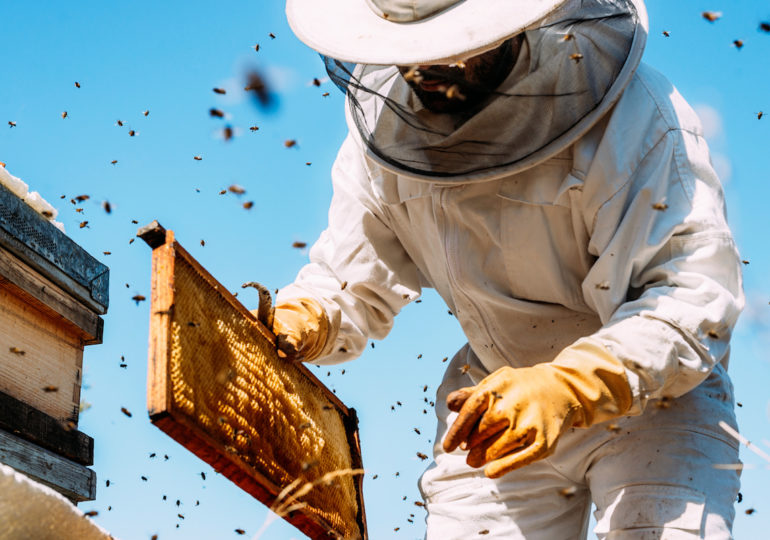Summer months are an exciting time as we watch our bees flourish, our hives grow in skyscraper style, and we anticipate the sweet rewards of our hard labor. Months of preparation, attentive husbandry, and keeping a cautious eye on the weather and the blossoms may soon pay off – in bees or honey at least.

These long day hot months afford us the opportunity to watch our bees collect, process, and dehydrate nectar; capping the year’s savory unique tastes under a lid of mandible molded wax. There is nothing more gratifying than pulling a pristine frame of fully drawn fresh wax capped honey with the purity and whiteness of nature. You know that feeling and you certainly anticipate that taste – it’s picture worthy. Although, that photo does not show the immense skill and care that it took to get to the extracting point nor does it demonstrate the amount of backbreaking work we all experience in exuding sweetness from the combs. It’s a hefty, but well-deserved task, that landscapes the table and allows us and our guests to savor the blossoms of the seasons past. Many of us after extracting who finally figured out what to do with those extracted frames take a well-deserved hiatus while our friends continue to labor amongst the great challenges of an impending summer. This includes dearth, which is the steep reduction or lack of nutritious life-giving nectar. Drought or the scarcity of water is another concern along with reduced pollen collection sources. These environmental changes intertwined with the population advent of summer scavengers and pests increases the stress amongst the family unit within our hives. It’s not only about our bees but our own behavior is affected as well. Combating a “hot to the touch” hive tool that has been heat soaked by the rays of the sun and dawning a frumpy hot (yea it’s so ventilated…) bee suit causes us to peer between sweat droplet moments of clarity. It is a chore, and many of us, myself included, find cause not to visit our bees during this time.
While we beekeepers rest and take solace in an air-conditioned cavity there are many opportunities we often don’t take advantage of during the sweltering summer months that would benefit both us and our bees. Sometime the preparation during the previous months has exhausted us or life simply gets our attention. While we savor our honey laden flakey honey biscuits have you ever sat and pondered and thought “wow, there are a lot of bees after I removed those supers”. Sometimes, and rightfully so, we look and we question ourselves should we have given them another box? It’s an interesting thought that usually comes to fruition in a moment of concern and sometimes it’s a task that we don’t give a second thought too. But thinking about those bees, that metropolitan population whose unemployment levels have now increased, should encourage us to take some action, as all we see are wash boarder jobs – you know that back and forth action on the front porch. Interesting to watch yes, but we should capture an opportunity to take advantage of the year’s highest population level and sustain our hive numbers in anticipation of future loss. As the summer solstice passes mated queen prices are usually at their lowest price level. Combine decreased mated queen costs, a reduction in natural resources, and high populations and we have a perfect formula for a summer split. Sure, it is easier said than done but with all the challenges of bee survival it is up to us, as beekeepers, to assist our friends and give them an opportunity to gorge on next year’s nectar. Now, we all have our unique methods of performing splits and regional differences exist, but summer splits offsets, and hopefully hedges against, predicted upcoming winter losses. Why should we scramble next spring for packages, nucs, or attempt to catch that unattainable swarm, just to up our hive numbers that previously succumbed to Old Man Winter’s wrath.
The simplest way to perform a summer split is to grab a few frames brood, a couple frames of resources, and place them in another separate brood chamber fitted with some of those frames that you just extracted. Either move those bees to a new location, keep them in the same yard, or use the methods you and fellow beekeepers have been successful with placement. You may think “I don’t need that many hives” but we do not know what environmental factors will affect our colonies during winter. Immense levels of snow, high internal moisture, inadequate resources such as honey, or the unsuspecting-tree that may fall due to freezing rain, gusts of wind, or heavy voluptuous snowfall. Make your splits as early as possible so that you have a minimum of two full brood cycles before going into winter. Adequately feed, feed some more, so that your colony has the resources enabling your queen to produce a large population of vibrant healthy winter bees. If your season runs late for honey harvest, consider pulling a frame of bees and brood from multiple hives and making up a new colony. Mated queens can be placed in this progressive split hive directly at the time of creation saving you time. Don’t worry about keeping your new colony queenless for a waiting period – Mother Nature will figure it all out, so again, just put that mated queen in her cage right in. Be patient, don’t poke the candy and give the new family time to mature. Check them in a week to ten days to see if the queen has been released and that you have eggs or young larvae. Some may consider using queen cells, virgin queens, or others may stimulate the colony to produce an emergency queen. These methods can work, just check your time table and make sure you have enough time to achieve a well mated queen and build up.
This task is one of many that we will do to prepare the bees for winter and in this case smaller population sizes have their advantages. Think about varroa treatments and the fact that population size influences and can concentrate molecule transfer. Manageable populations may come in contact more often with treatments and the act of feeding, while treatments are present, encourage the bees to move and be more active inside the hive giving many a better opportunity to brush up against an Apivar strip; for example. Remember after the flow, the amount of eggs laid are reduced and varroa mite levels increase. Taking advantage of this knowledge by doing summer splits and reducing the bee population size, may encourage survivability, sustainability, and increased health. Smaller equalized colonies also may have a reduced propensity to rob, especially if they have been or are well fed. Traditionally, bee keeping has been a routine experience, where for years, we would practice the same husbandry skills based on the calendar and the flow. As the advancement of pests and scavengers as well as pathogens has evolved, our past repeated efforts are no longer effective and we must be fluid in our approach. We’ve heard it so many times that we must monitor or might levels; yes, it is important because it offers us a benchmark as well as a condition that will allow us to possibly predict or anticipate. It’s easy to monitor while making splits. Know your numbers, and if nothing else this summer, monitor!
As the calendar moves forward we can often find ourselves rushing to complete those unattended tasks. Life has a way of delaying our good intended goals which ultimately may affect colony survival. Be proactive and consider making just a few summer splits and see how this works for you. Happy beekeeping!
Join the Véto-pharma community and receive our quarterly newsletter as well as our occasional beekeeping news. You can unsubscribe at any time if our content does not suit you, and your data will never be transferred to a third party!

© 2019-2024, Véto-pharma. All rights reserved